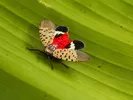What You Need to Know About the Spotted Lanternfly
Moving without letting invasive insects tag along
Any long-distance move will have important tasks, like planning a route (if you’re driving) and choosing a reliable mover. When you’re relocating from one of the quarantined states with confirmed spotted lanternfly populations, extra steps are involved to reduce the spread of the pesky insect.
Keep reading to learn more about the bugs, where they live and what to do if you find evidence of them.
Why are spotted lanternflies bad?
Invasive species like spotted lanternflies and spongy moths can damage crops, plants and trees. Spotted lanternflies feed on multiple plants and trees, including grapes, hardwood trees, hops and stone fruits.
Not only do spotted lanternflies eat the greenery, but they also leave behind a sticky fluid called honeydew that causes mold on the leaves.
What states are part of the quarantine?
The spotted lanternfly originated in Asia and was discovered in Pennsylvania in 2014. Since then, it has spread throughout the Northeast, Mid-Atlantic, Midwest and South regions of the United States.
As of March 2025, the United States Department of Agriculture has confirmed the presence of the spotted lanternfly in 18 states, plus Washington, D.C.
These states are currently affected:
- Connecticut
- Delaware
- Georgia
- Illinois
- Indiana
- Kentucky
- Maryland
- Massachusetts
- Michigan
- New Jersey
- New York
- North Carolina
- Ohio
- Pennsylvania
- Rhode Island
- Tennessee
- Virginia
- West Virginia
What does a spotted lanternfly look like?
Juvenile insects or nymphs are black with white spots and turn red as they grow. Adult spotted lanternflies prove that looks can be deceiving. The mature insects are quite pretty and distinctive. Their forewings are light brown with black spots at the front and a speckled band at the rear. Their hind wings are dark red with black spots at the front and black with a white bar at the rear.
Check out the photo below and view more images on the USDA website.

An adult spotted lanternfly resembles a tan, red and black moth.
How to spot the bugs
Both nymphs and mature spotted lanternflies gather in large groups when feeding. Look for the insects at dusk while they move around on tree trunks. When it’s daylight, the bugs hide near the base or canopy of plants.
Spotted lanternflies particularly enjoy tree-of-heaven plants. You might also notice the presence of the insects by the intense scent they leave behind. As their honeydew ferments, it creates a rotten odor.
Identifying eggs
When fresh, the egg masses look like a smear of wet, gray putty, turning dull and brown as they age. The masses are typically about 1 inch long and contain between 30 and 50 eggs. They’re often seen in fall, winter and spring on flat surfaces like cars, fences, grills, trees and outdoor toys or equipment.
What to do if you’re moving from a quarantined state
Relocating from or through a quarantined area to a place trying to prevent the spread (Alaska, Canada, Hawaii, Oregon and Washington) requires some extra planning. You’re required to search for the insects while packing your things and destroy them. Failing to do so violates regulations by the USDA or the Canadian Food Inspection Agency (CFIA) and could result in a fine.
If you’re using U-Pack® and it applies to your move, we’ll send you an Insect Inspection Form to comply with regulations. It will also be available through the U-Pack customer dashboard.
While preparing your belongings for shipping, take time to review U-Pack’s Do Not Ship List.
How to get rid of spotted lanternflies
If you find live insects or egg masses, the USDA suggests smashing them and scraping the remains into a plastic zippered bag with hand sanitizer or rubbing alcohol. Afterward, seal the bag and throw it in the trash.
Need help with an infestation? We recommend contacting a licensed pest exterminator.
Have questions?
If you have questions about U-Pack’s Insect Inspection Form or need help with your move, please let us know in the comments or call 844-362-5303844-594-3077 to speak to a moving consultant.
Suggested reading: Tips for moving during cicada season.
More articles you might like...



